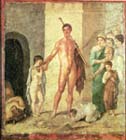Examine a Roman Painting
by
John J. Dobbins

There are several ways to look at this painting. Our first impulse might be to identify the myth that is depicted. That is fine as far as it goes. The danger is that after identifying the myth we may think that we have done all that is required of the painting. Big mistake! There is more to this painting than its narrative content. Identifying the myth is only the beginning.
What about those of you who don't know the myth? Should you abandon the painting and check out another Web site? Not necessarily. Given that the painting is compositionally interesting, we could analyze its formal elements even if we don't know the myth. By "formal elements" I mean the components that give the painting its shape, or form (balance, symmetry, line, shapes, contrasts, color balance or contrast, etc.). This approach is interesting as far as it goes, but it has its own limitations. It doesn't really tell us what the painting is about, so let's move on.
Here our analysis can take advantage of the Web's capacity to let you follow your own path. Here are several options:
Figure out the myth if you don't know it already.
Get some background on the painting.
Copyright 1998 by John J. Dobbins, all rights reserved
Document URL: cti.itc.virginia.edu/~jjd5t/roman-ptg/top.html
Last Modified: Tuesday, 30-March-98 12:00:00 EDT